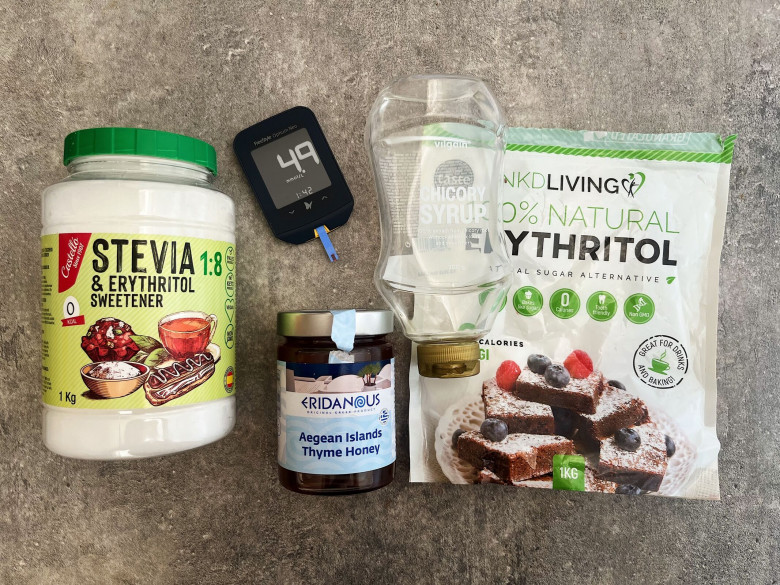How To Choose A Sugar Substitute — The Ultimate Guide
I’m Tonya, and I have Type 1 diabetes. Over the past few years, I’ve tried a wide range of sugar alternatives. Some with great results, others not so much. In this guide, I want to share what I’ve learned: what actually works (especially if you’re managing diabetes), what doesn’t, how to use these substitutes effectively, and generally bring some order to the overwhelming world of natural and artificial sweeteners.
A short, but important disclaimer: I’m not here to convince you to switch to sugar substitutes, nor do I consider them a magic bullet and inherently healthy. Many of them come with caveats of their own. My goal is to present the options clearly, with all their benefits and trade-offs, so you can make informed decisions .
How Sugars Are Metabolized
Before diving into the specifics of individual sweeteners and sugar substitutes, it will be helpful to understand how different sugars and sugar substitutes are processed in our bodies, as it will help to make sense of the differences we’ll explore later.
There are three main classes of carbohydrates.
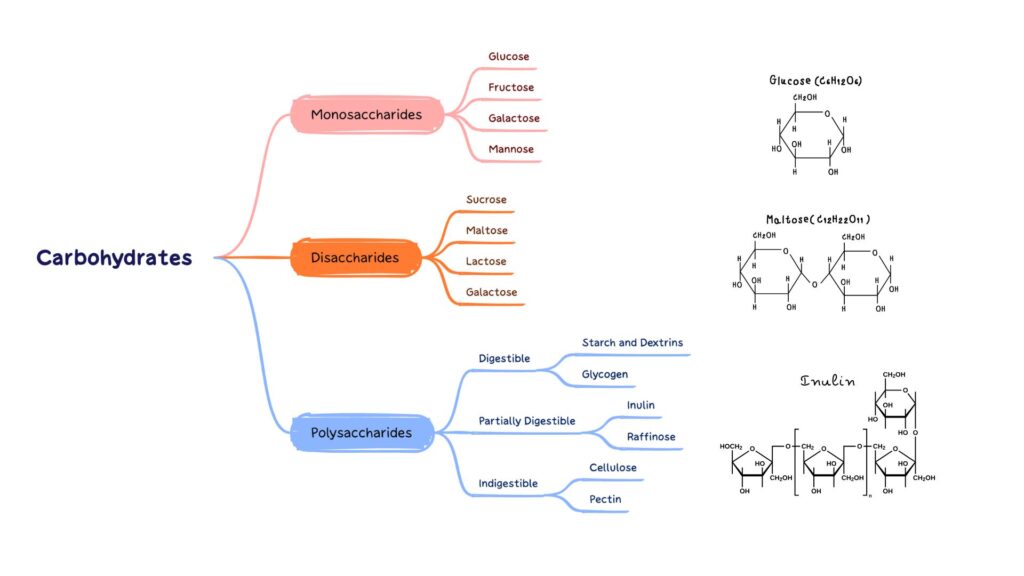
Carbohydrate digestion starts in the mouth, where enzymes begin breaking them down to basics, into smaller building blocks. Salivary amylase (enzyme in human salive) starts breaking down polysaccharides (for example starch) into shorter chains. Then, in the duodenum(first part of the small intestine), pancreatic amylase continues the process. Finally, in the small intestine, enzymes maltase, lactase, amd sucrase break down disaccharides into monosaccharides.
For example:
- Maltose → glucose + glucose
- Lactose → glucose + galactose
- Sucrose → glucose + fructose
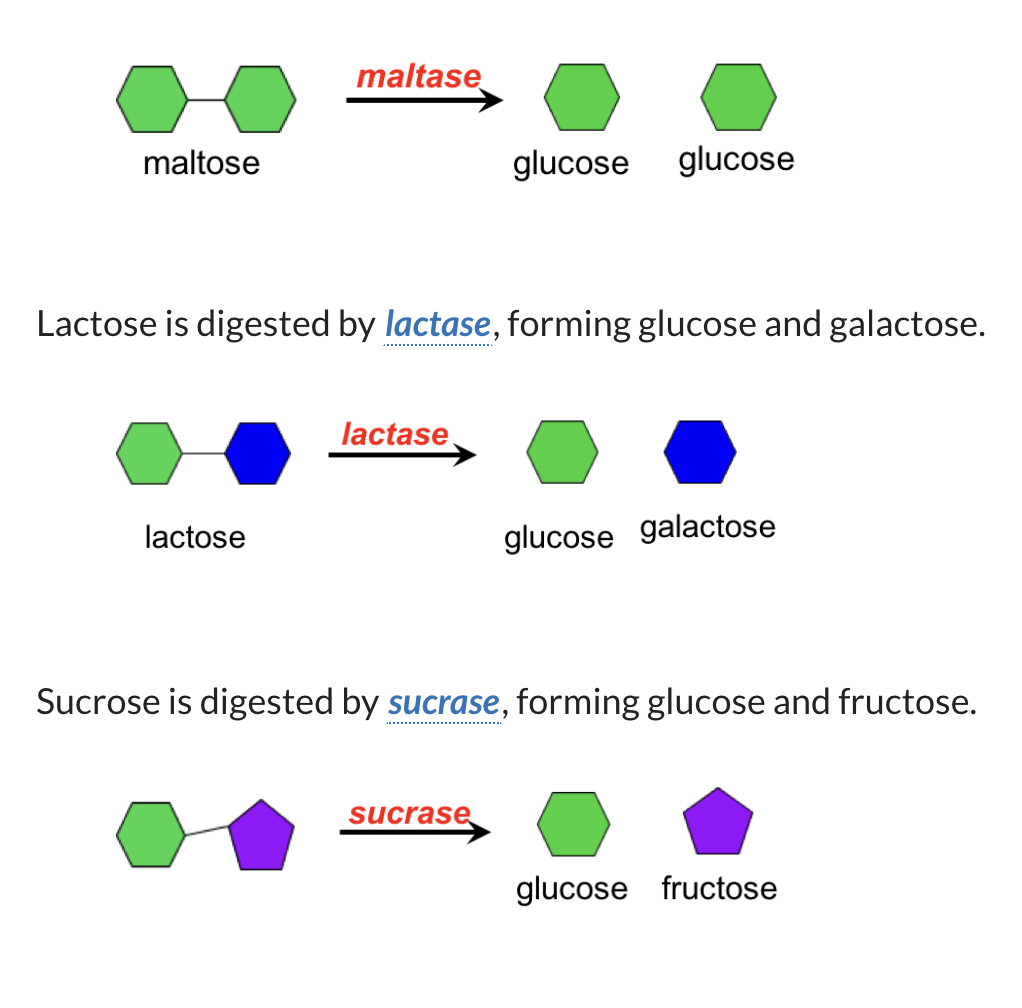
By the way, starch is just a long chain of glucose units. It doesn’t matter where it originates from: potatoes, bread, or grains. So no matter the source, it’s eventually broken down into glucose.
These resulting monosaccharides are absorbed through the walls of the small intestine and enter the portal vein, which carries them straight to the liver — our body’s “Carbohydrate Command Center.”
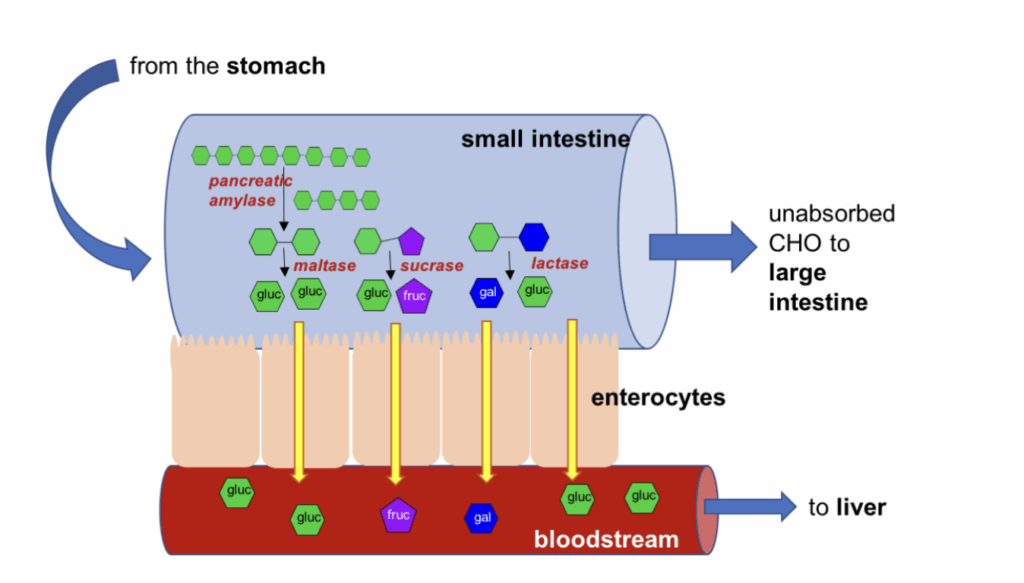
And that’s where things start to get interesting:
- Glucose is partialy stored in the liver as glycogen*, but mostly it passes through and enters the bloodstream to provide energy to the brain, muscles, and other organs.
- Fructose is almost entirely processed in the liver. There multiple destinations it can end up at:
- It can be turned into glycogen, our emergency reserve of glucose
- It can be used to synthesize fatty acids (de novo lipogenesis), especially if there’s excess energy
- Finally, it can be converted into glucose, to a small extent, if needed
- Galactose is also mostly metabolized in the liver, where it’s either turned into glucose or used to build glycogen.
🔁 This bit about fructose is important. We’ll come back to it when we look at healthy sweeteners.
*Glycogen is the body’s glucose reserve, stored in the liver and muscles. But only liver glycogen can release glucose back into the bloodstream for use throughout the body, as muscle glycogen is reserved strictly for the muscles themselves.
Alternative Sugars — Agave, Coconut & Palm Sugar, and Chicory Syrup
I often hear things like: “White sugar is bad for you, use honey or coconut sugar — that’s a healthy option”.
Let’s be clear: sugar is sugar. Its color or form doesn’t change that.
Things like coconut or palm sugar are often marketed as a healthier choice, unfortunately, it’s quite far from the actual state of things. While those alternatives may sound more wholesome and natural, their calorie content and impact on blood glucose are nearly identical to regular table sugar. The differences mostly come down to taste and trace amounts of minerals, which you’d need to consume in unrealistic quantities to see any benefit.
For example, to get even 10% of your daily recommended intake of potassium, magnesium, iron, or zinc from honey, which it’s often praised for, you’d need to eat 200–400 grams of it. So let’s stop fooling ourselves: honey is still sugar. We eat it because it’s delicious, not because it’s a superfood.
Their glycemic index may differ slightly, meaning your blood sugar might rise a bit more slowly, but it’s a very small difference.
So realistically, the only real difference is in the taste.
I’ve put together a visual table showing the micronutrient content of honey.
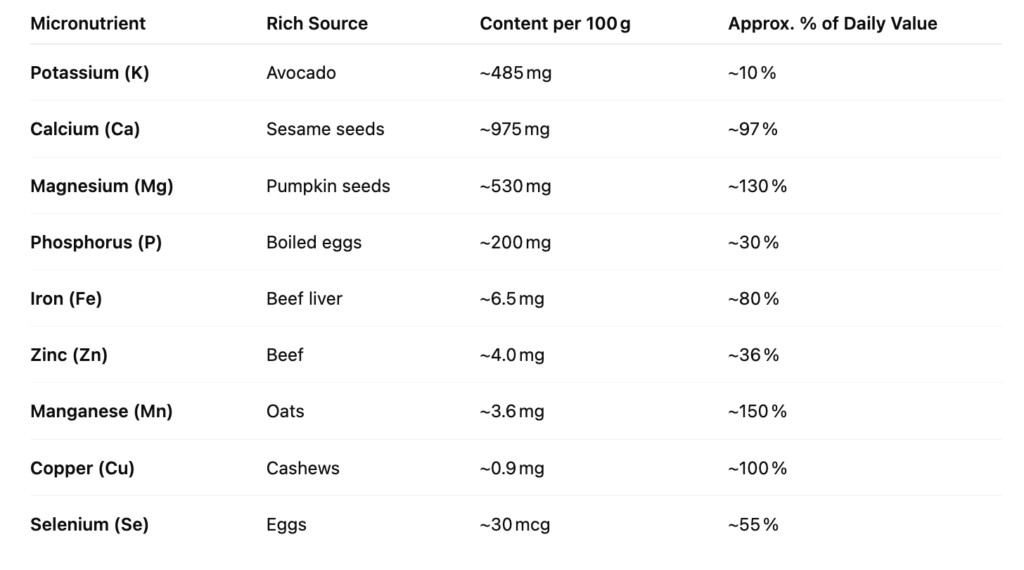
To be clear, I’m not saying you shouldn’t ever eat honey. It’s delicious, and even with diabetes, I sometimes enjoy it as part of a meal or as a dessert ingredient that gives more depth and flavour. But honey is still considered to be added sugar. And organizations like the WHO, AHA, and ADA recommend limiting added sugars to 25–35 grams per day.
Among the trendy syrups and “healthier” alternatives, there’s one more interesting contender: agave syrup, often praised for its impressively low glycemic index.
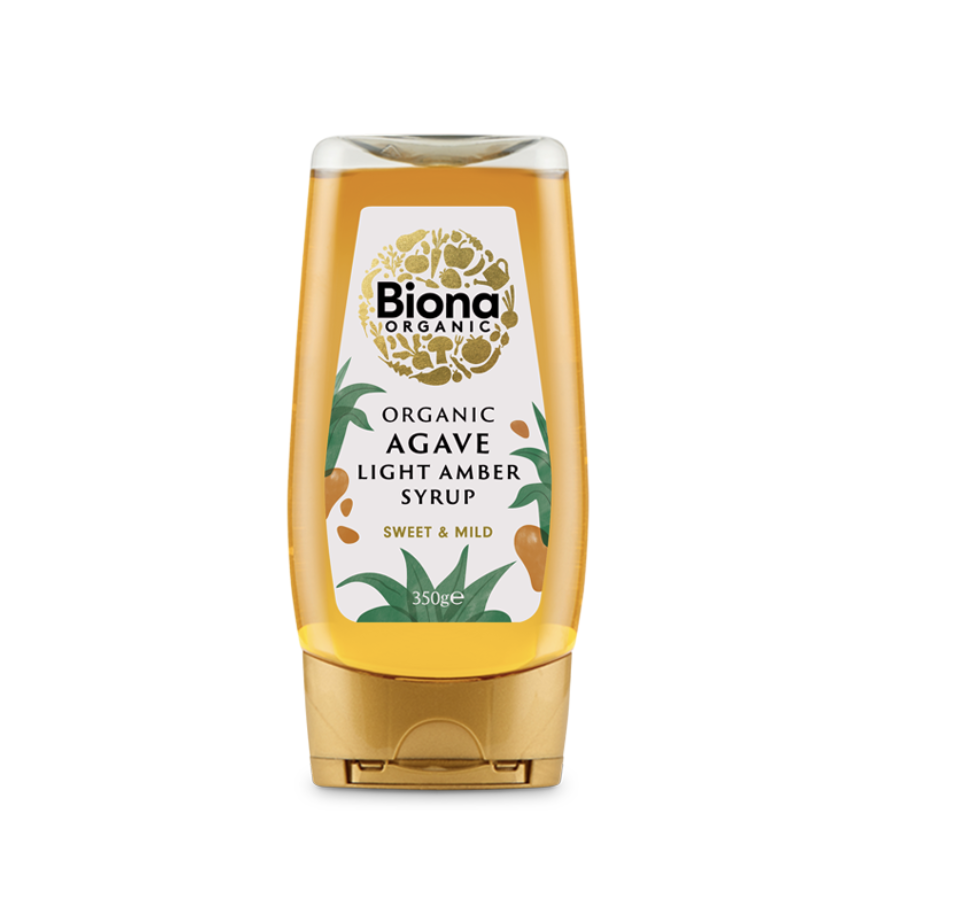
This is the one thing I strongly don’t recommend adding to your menu, especially if you have prediabetes, diabetes, or are actively watching your metabolic health.
Agave syrup is composed almost entirely of fructose (up to 85%), which, as we discussed earlier, is metabolized in the liver. While it won’t cause a sharp blood sugar spike, excessive fructose intake can prompt the liver to ramp up fat production in the form of triglycerides. Chronically elevated triglycerides are a known risk factor for insulin resistance, type 2 diabetes, and cardiovascular disease. In trying to avoid diabetes, we may actually be accelerating its onset.
Important clarification: fructose isn’t inherently toxic, it’s the excess that’s the problem. And when you use pure fructose as your go-to sweetener, it’s very easy to overdo it.
To make this easier to understand, I’ve put together a comparison table showing the calorie content, sugar composition, fiber content, and glycemic index (GI) of popular “healthy” syrups and sugars.
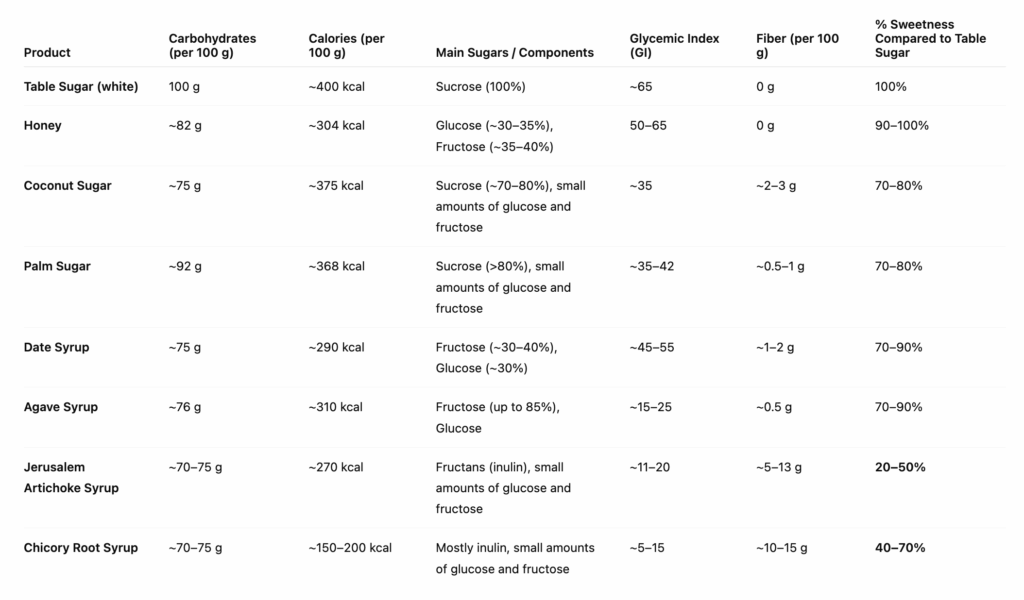
And here’s where you might notice an interesting outlier at the very end of the table: chicory syrup.
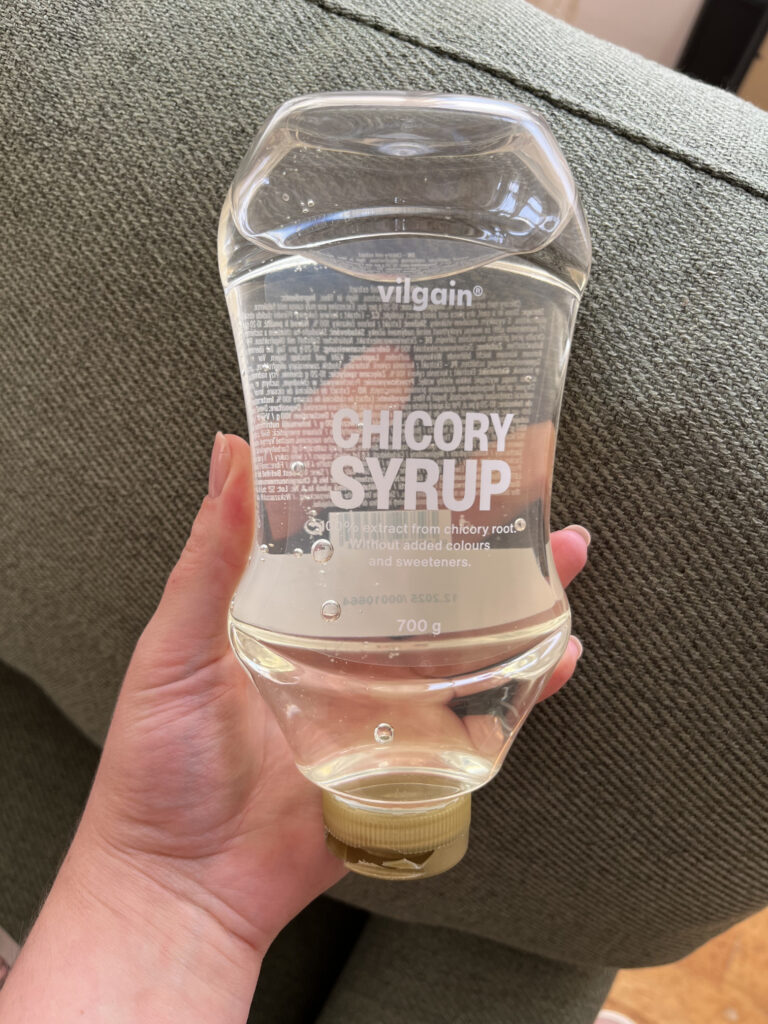
From a nutrition perspective, chicory root syrup looks almost magical: sweet, yet packed with a significant amount of fiber.
The syrup is made from inulin, a compound found in chicory root.
Inulin is a natural polysaccharide from the fructan family, made up of fructose units linked by β-bonds (unlike regular sugars, which have α-bonds). Essentially, it’s a soluble fiber that humans cannot digest in the small intestine because we lack the enzymes to break those β-bonds.
Chicory syrup is believed not to raise blood sugar levels. I haven’t found any studies specifically on people with diabetes, so I won’t make any definitive claims. My personal tests haven’t shown any blood sugar spikes, but I haven’t yet tried using this syrup as the sole sweetener in a dessert that’s part of a meal I’ve covered with insulin.
Chicory syrup may contain some fructose and glucose, and the percentage varies by manufacturer, so check the label. However, the amount of simple sugars is still quite low.
In a nutshell, chicory syrup:
- Has almost no effect on blood glucose levels
- Acts as a prebiotic, feeding gut bacteria
- Contains soluble fiber
Are there any drawbacks? I can think of a couple:
- About 2–3 times less sweet than table sugar
- It can cause gas and, if overeaten, diarrhea in sensitive individuals (like other fermentable fibers). But the gut can adapt gradually if introduced slowly.
So, how safe is it, and how much can we eat it? The optimal dose of pure inulin is considered to be 5–10 grams per day, which most people tolerate without any digestive issues. That corresponds to about 20–30 grams of chicory syrup.
Sugar Substitutes
There are 3 main types of sugar substitutes:
- Artificial sweeteners
- Sugar alcohols
- Novel sweeteners
Artificial sweeteners
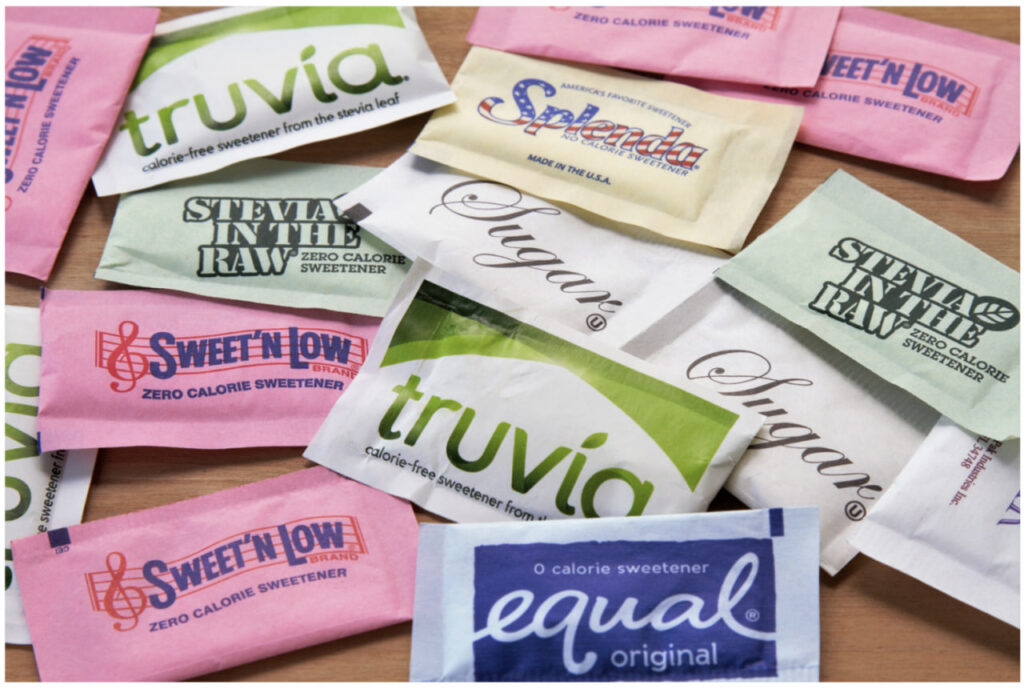
These sugar substitutes are typically 200 to 700 times sweeter than regular sugar and were developed entirely in laboratories. They’ve had a controversial and sometimes scandalous reputation since their discovery, and a lot of that skepticism persists today.
The first sugar substitute, saccharin, was discovered all the way back in 1879 by Konstantin Fahlberg and Ira Remsen. Saccharin was widely used during WWI and WWII. Due to disrupted sugar supplies, it became essential despite being banned at the time as a carcinogen.
However, the actual boom in discovering this class of sweeteners happened in the 1960s and ’70s. Most discoveries were actually accidental: researchers in labs “found” them when they forgot to wash their hands after experiments and licked their fingers (let’s not dig into the safety story here). During this period, aspartame, acesulfame K, and sucralose were identified. Since then, only improved versions of aspartame and steviol glycosides (from stevia) have emerged.
These substitutes contain no nutrients, are virtually calorie-free, and for a long time were the main sugar alternatives for people with diabetes or weight management issues.
They can have a somewhat distinctive taste and sometimes a slight bitterness, especially if used in larger amounts.
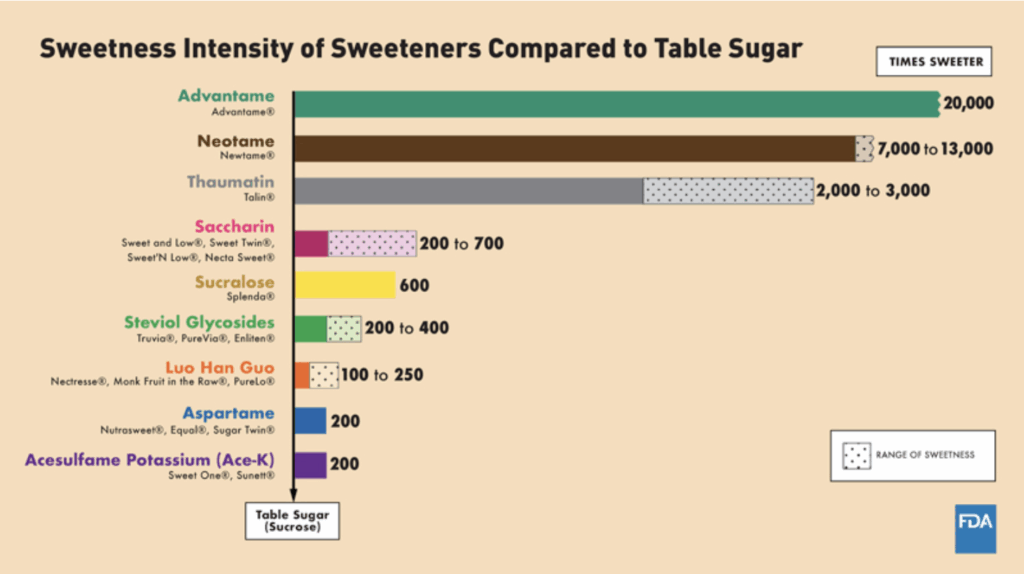
How Do They Work
Artificial sweeteners behave differently in the body depending on the compound:
- Acesulfame K and saccharin are barely absorbed. Around 95% is excreted unchanged.
- Sucralose is poorly absorbed (about 10–15%), and not metabolized.
- Aspartame is fully absorbed and broken down into aspartic acid, phenylalanine, and methanol.
- Neotame is minimally absorbed (~2%).
Note that only aspartame contributes calories, about ~4 kcal/g upon full breakdown. But because it’s about 200 times sweeter than sugar, the actual caloric intake is negligible.
This entire category of sweeteners is regulated by the FDA, and currently approved compounds include:
- Acesulfame potassium (E950)
- Aspartame (commonly found in diet colas) (E951)
- Neotame (E961)
- Saccharin (E954)
- Sucralose (E955)
Common brand names include Equal, Splenda, and Sweet’N Low, and others, depending on the country where they are being produced and sold.
These sweeteners are cheap to produce and widely used in “sugar-free,” “low-sugar,” and other “diet” versions of syrups, soft drinks, and jams. However, many of them are not heat-stable and lose their sweetness when exposed to temperatures above ~150°C, which is why they’re rarely used in baking.
By the way, “reduced sugar” jams often contain something like aspartame to bring the sweetness back up to standard levels. So less sugar doesn’t always mean less sweet.
Early studies on lab animals suggested a possible link between some artificial sweeteners and cancer. However, more recent research on humans has not confirmed any carcinogenic effects when these substances are consumed within approved limits (1). The FDA considers them safe when used within the established Acceptable Daily Intake (ADI).
There is an important exception: people with phenylketonuria (PKU) should avoid aspartame due to its phenylalanine content.
Here are the current ADI limits for artificial sweeteners:
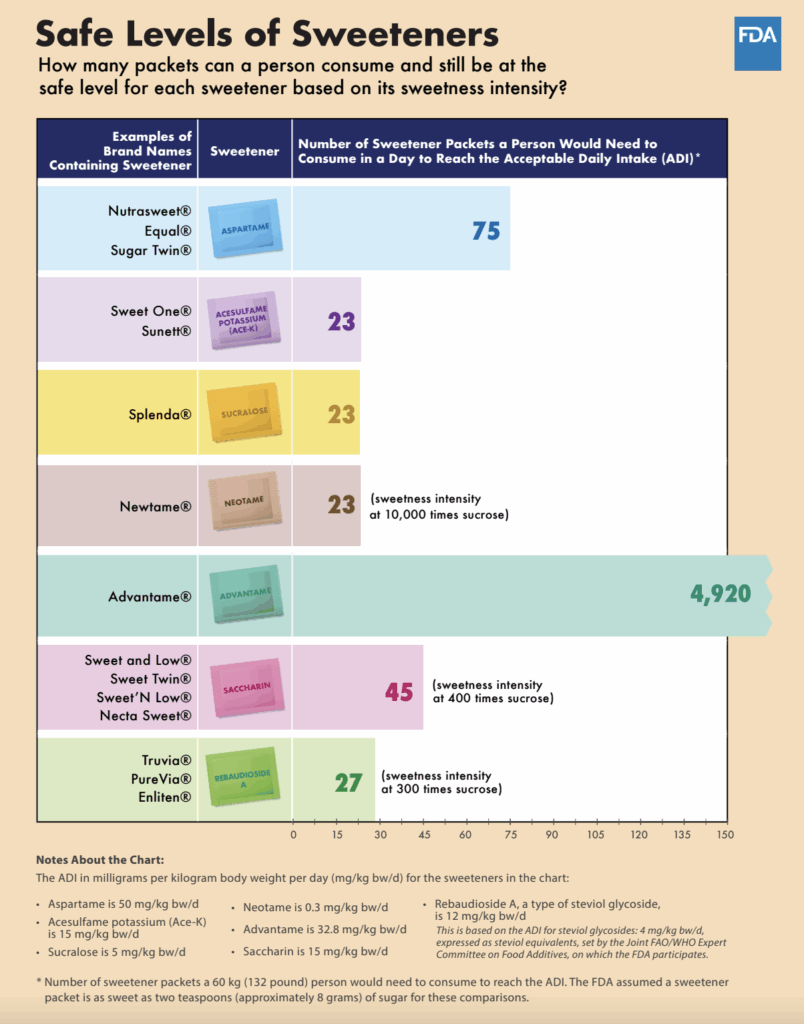
Sugar alcohols
Sugar alcohols are a type of carbohydrate that structurally resembles both sugar and alcohol, but don’t contain ethanol.
They occur naturally in small amounts in certain fruits and are classified as nutritive sweeteners, since most of them provide some calories and can raise blood sugar levels, though not as sharply as regular table sugar.
They’re usually less sweet than table sugar and often have a slightly different taste profile. For example, erythritol leaves a noticeable cooling sensation in the mouth as an aftertaste.
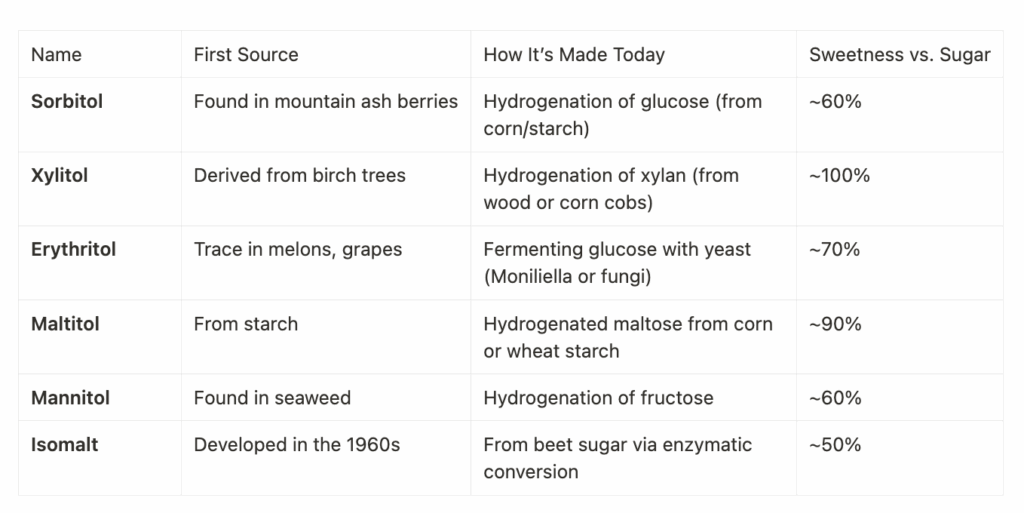
Just like artificial sweeteners, sugar alcohols were first discovered in the late 19th to early 20th century. Their widespread industrial usage took off in the 1940s–60s, not only as sweeteners, but also as stabilizing agents in various food products.
Different sugar alcohols are processed differently in the body:
- Erythritol is fully absorbed in the small intestine, but around 90% is excreted unchanged by the kidneys within 24 hours. As a result, it has virtually no effect on blood sugar levels.
- Xylitol, sorbitol, and maltitol are only partially absorbed and metabolized, so they can raise blood sugar levels, though not as sharply as regular sugar.
Most sugar alcohols also contain calories. So when you reach for a “sugar-free” chocolate bar and assume it’s a diet product, there’s a good chance it’s sweetened with maltitol, which still has both carbs and calories.
I’ve put together a table showing the calorie and carbohydrate content of the most common sugar alcohols.
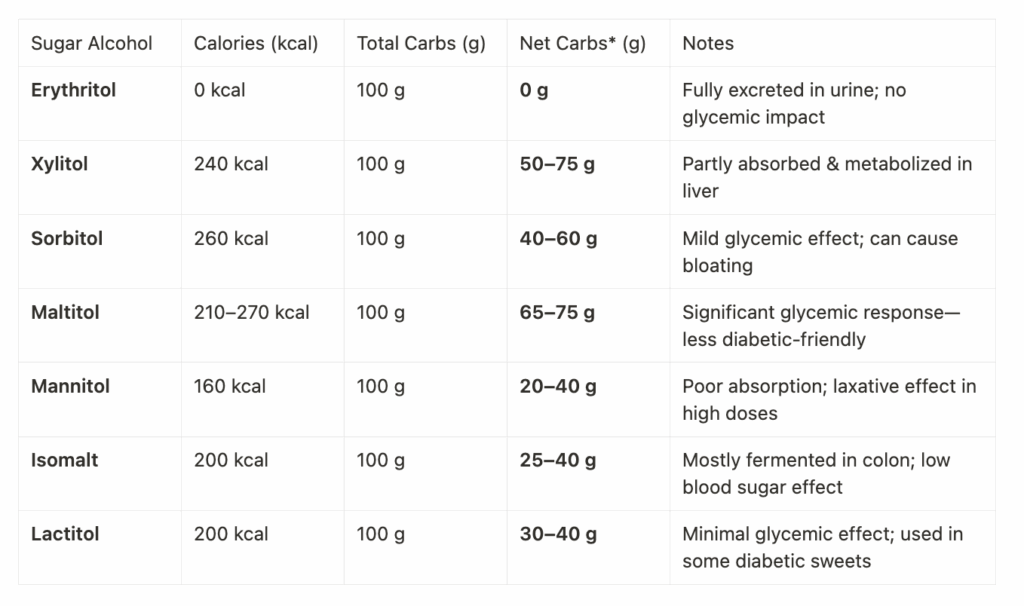
Sugar alcohols are poorly fermented by cavity-causing bacteria in the mouth, which means that, unlike regular sugars, they don’t contribute to tooth decay. In fact, xylitol may even help remineralize tooth enamel and has documented anti-cariogenic properties. That’s why you’ll often see it in chewing gum.
On the downside, sugar alcohols can have a noticeable laxative effect.
If you consume more than 50 grams per day, it can lead to bloating and diarrhea. For some people, even smaller amounts can trigger digestive issues. So be cautious with “sugar-free” protein bars, as these are often loaded with sugar alcohols. When running or having an intense exercise, it’s easy to overdo it without realizing it and end up with GI troubles.
Unlike many artificial sweeteners, sugar alcohols are heat-stable, which makes them suitable for baking. That’s why they’re used in low-sugar baked goods.
Among them, the erythritol stands out noticeably: it contains zero digestible carbs and virtually zero calories. But it’s not perfect. Aside from its signature cooling aftertaste, it tends to recrystallize and can dry out baked goods once cooled. The good news is that this can be managed by blending it with other sweeteners.
A new study was recently published regarding erythritol and its potential impact on the cardiovascular system: https://journals.physiology.org/doi/abs/10.1152/japplphysiol.00276.2025
It’s important to note that this is an in vitro study, and further research is needed to confirm or refute the hypothesis.
Novel sweeteners
These are currently the trendiest and most hyped sugar substitutes.
They’re classified as “natural” because they’re derived from plants or synthesized based on plant compounds.
Here’s what sets them apart:
- They are many times sweeter than sugar
- They contain no calories or digestible carbs
- They generally don’t raise blood glucose levels, since they either contain no carbohydrates at all or only trace amounts
- They are not broken down by human digestive enzymes.
For example, steviol glycosides (from stevia), thaumatin, and brazzein are complex proteins or glycosides. Our digestive system can’t process them like typical sugars, so they mostly pass through the gut or are metabolized by the liver in tiny amounts, without releasing glucose into the bloodstream.
They tend to have a clean, sugar-like sweetness. Stevia is the exception for some people, as it can leave a slightly bitter aftertaste that many find unpleasant.
The FDA continues to monitor these sweeteners and has classified six of them as GRAS (Generally Recognized As Safe).
Among the newest and most promising are thaumatin and brazzein — sweeteners extracted from African fruits. They have little to no aftertaste and are dozens of times sweeter than sugar. We’re likely to see them used more widely in the near future.
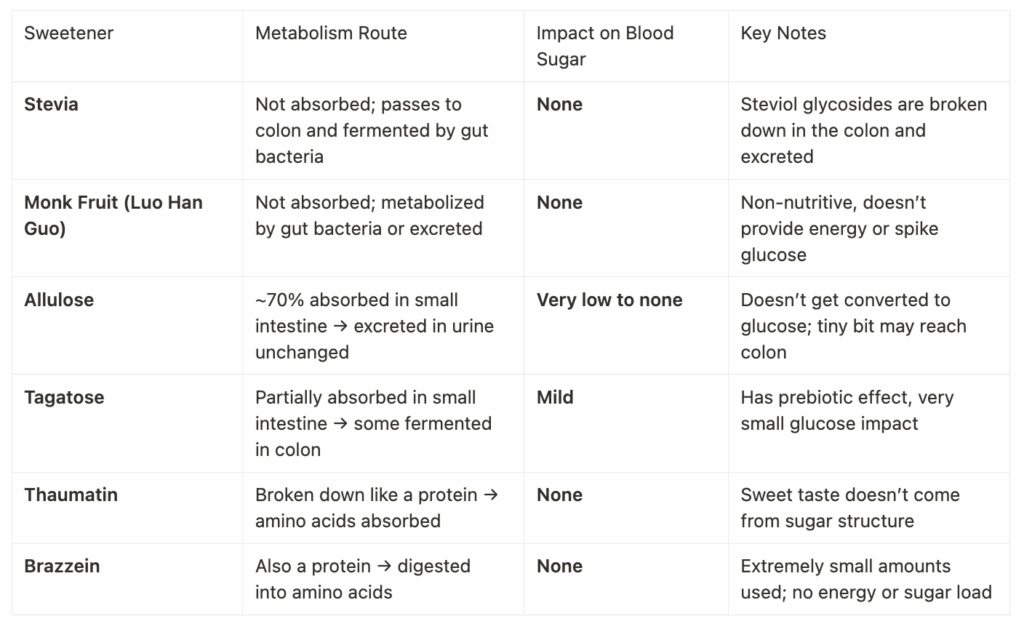
Allulose
One of the sweeteners in this category is a standout star — Allulose.
Allulose is a unique product, not just in terms of taste, but because it’s one of the very few sugar substitutes that caramelizes like real sugar. Isomalt has a similar effect, but it tends to just “melt stickily” rather than truly caramelize.
You can use allulose to make caramel, condensed milk, and anything that requires sugar’s structure and physical properties, not just its sweetness.
In Europe, it’s still not officially approved for sale, so your best bet is to order it from iHerb. In the USA and SEA, it’s widely available in many forms: granulated, liquid, powdered, and on many marketplaces.
Allulose is technically a monosaccharide. It’s a type of carbohydrate, but it’s not absorbed in the intestine, doesn’t raise blood sugar, and provides just ~0.2 kcal/g. Because of this, it’s not considered a “true” carbohydrate, and its net carb value is effectively zero.
It’s a rare type of sugar, structurally similar to fructose, but with a slight difference in the spatial arrangement of its atoms.
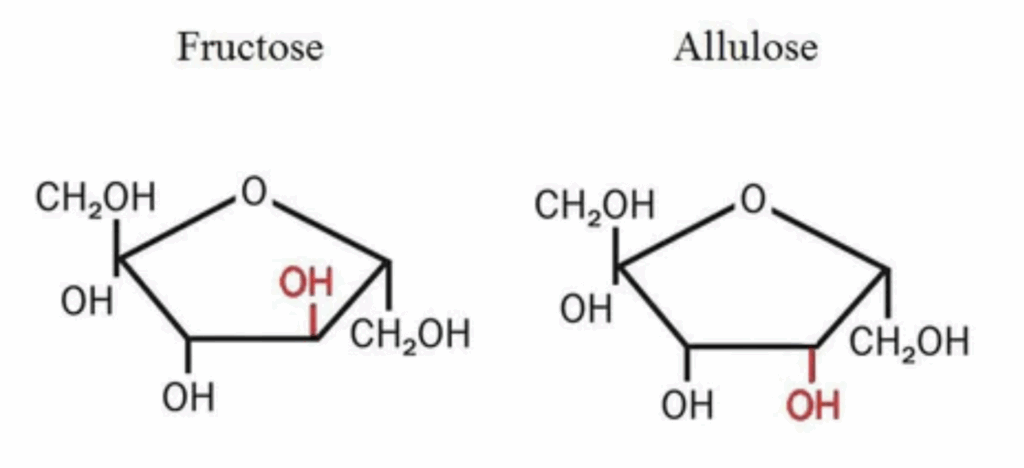
Around 70–85% of the allulose volume that a person can consume is absorbed in the small intestine, but it isn’t metabolized and is excreted almost entirely unchanged through the kidneys. The rest ends up in the large intestine, where it can be fermented by gut microbiota.
Just like sugar alcohols, too much allulose can have a laxative effect, and it’s best not to overdo it. Consuming 30–50 grams per day is generally considered safe.
Monk Fruit
Also known as Luo Han Guo, Siraitia Grosvenorii, and Swingle Fruit. This isn’t a new product. It has been used for years in traditional Chinese medicine, not as a sweetener, but as an ingredient in herbal teas. It’s believed to help with colds and sore throats.
Here’s what dried Monk Fruit looks like. It’s still sold in traditional pharmacies today.
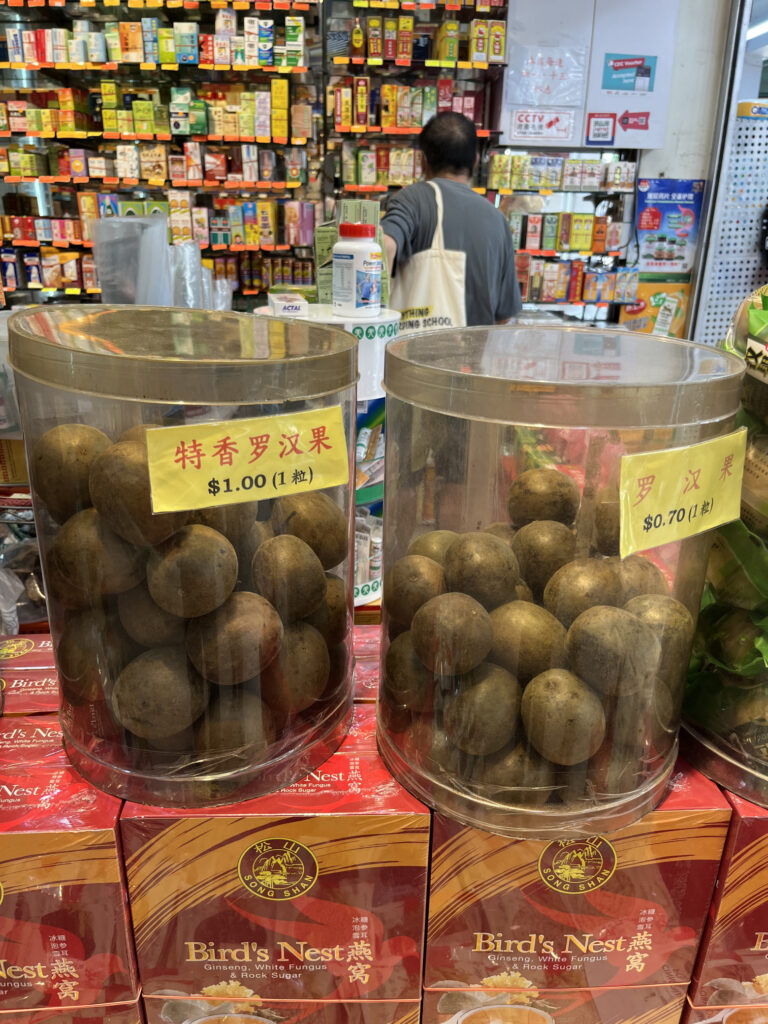
As a sweetener, monk fruit’s popularity is heavily driven by marketing. It’s expensive, yet in its powdered form, it’s almost always sold as a blend, typically 98–99% other sweeteners (usually erythritol), and only 1–2% actual monk fruit. Meanwhile, pure erythritol on its own costs about half as much. It’s a frustrating and frankly a bit deceptive setup.
If you’re going to buy monk fruit, go for the extract or syrup, not the blends.
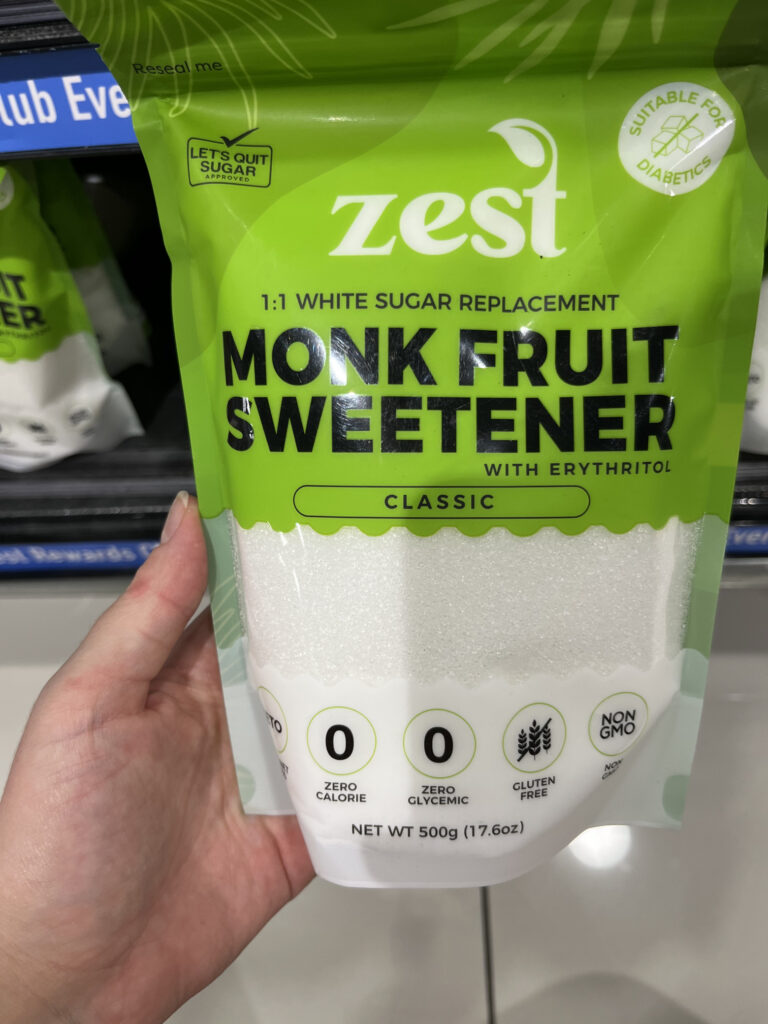
Stevia
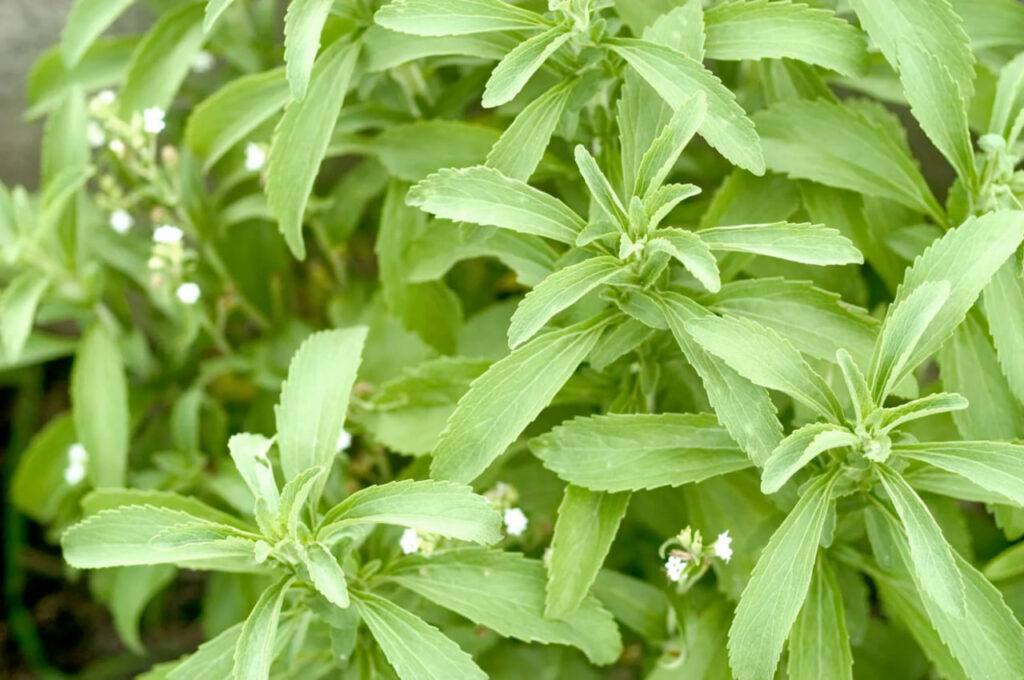
Like monk fruit, stevia is often sold blended with erythritol, but in this case, it’s a smart combination, both in terms of flavor and cost.
Stevia activates both sweet and bitter taste receptors, while erythritol activates only the sweet ones. When combined, a kind of “competitive receptor activation” occurs, where the bitterness of stevia is partially masked by erythritol.
As a result, erythritol improves the taste profile of stevia, while stevia’s high sweetness means you can use less erythritol, which greatly helps to reduce its potential laxative effect. It’s a very well-balanced pairing.
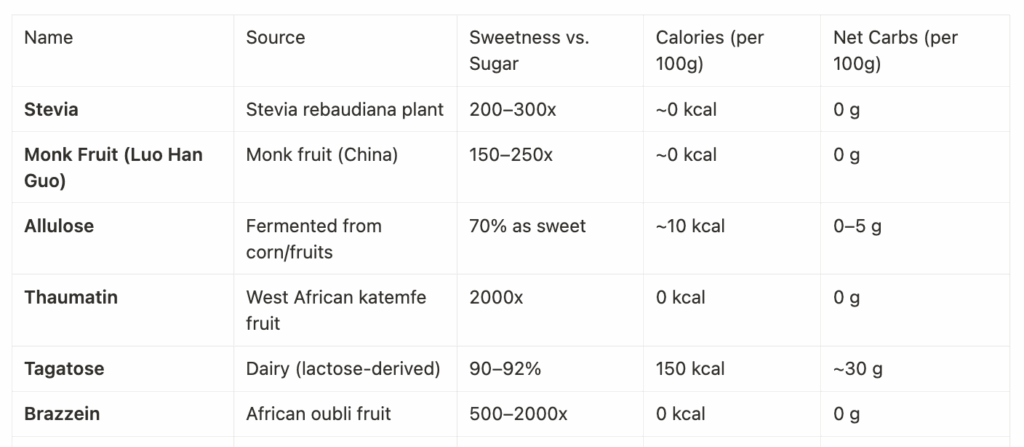
To round things out, I’ll point you to a great infographic from The Washington Post. They pulled together most sugars and sugar substitutes and sorted them by key characteristics, making the whole landscape much easier to navigate.
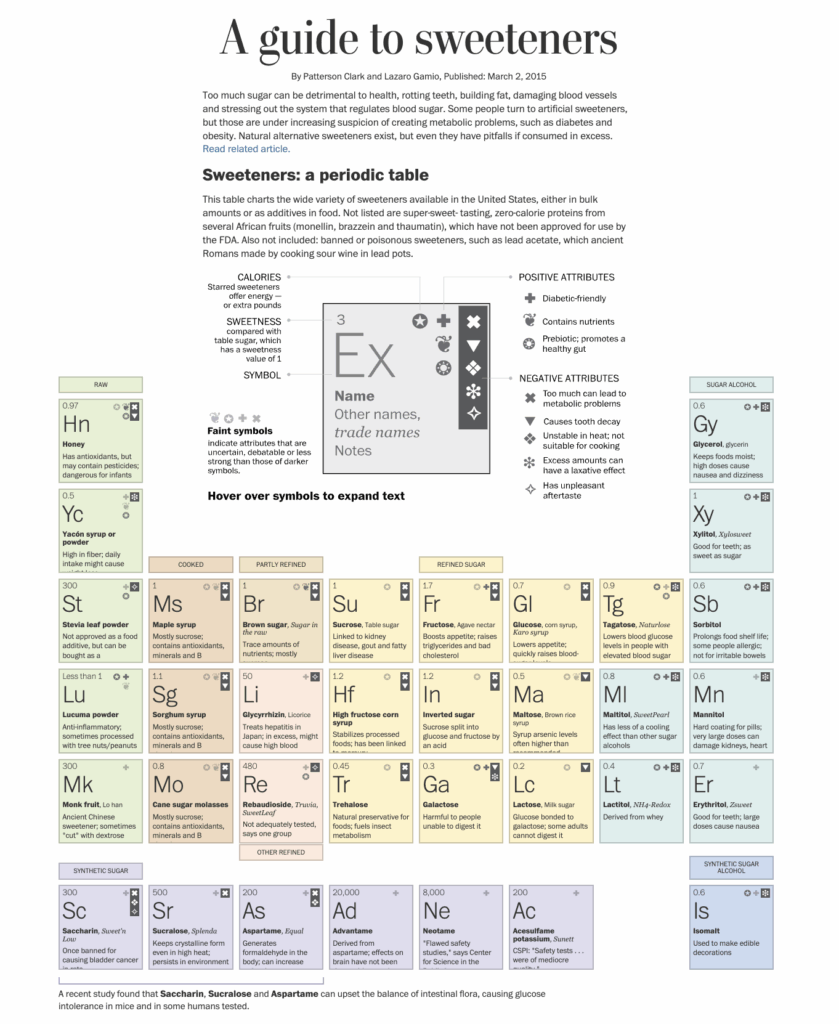
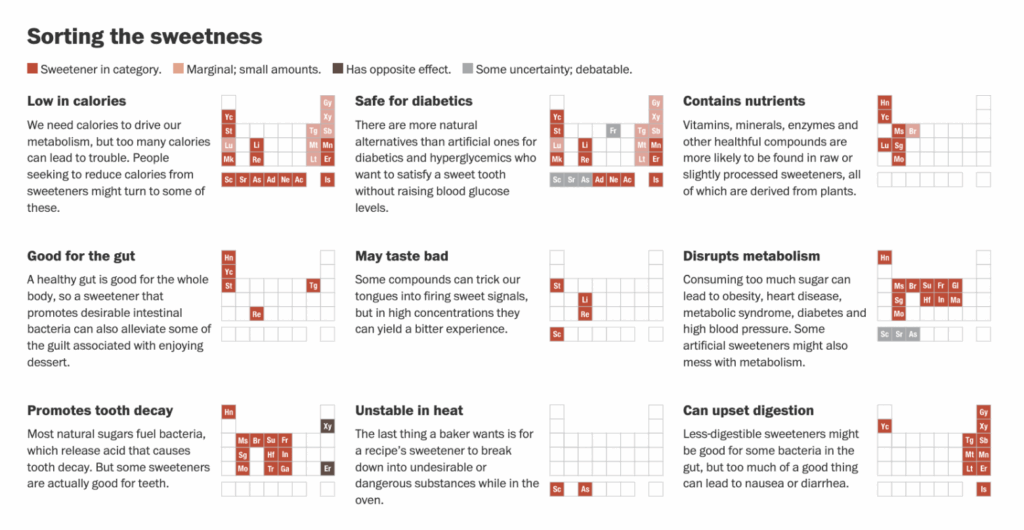
How to Choose a Sugar Substitute
Choosing a sugar substitute depends on your taste preferences, safety concerns, and most importantly, the dish you’re using it for.
A sugar substitute is not sugar. It gives you sweetness, but it’s a completely different compound. You can’t simply cut sugar out of a recipe and replace it with a sweetener. Sugar plays many other roles: stabilizing the structure, preserving shelf life, adding bulk, and keeping baked goods moist. That’s especially critical in desserts and baked goods.
As mentioned earlier, some sweeteners are heat-stable, others are not. Non-heat-stable sweeteners are best for drinks or sweetening jams, sauces, or syrups after they’ve been cooked. If you bake with them, their sweetness can break down under heat.
Also, keep in mind that most sweeteners don’t dissolve in fat. So if you’re replacing honey in a salad dressing that has no water, go for special syrup-based sweeteners instead, like chicory root syrup or monk fruit syrup.
Drinks
- Chicory root syrup
- Monk fruit syrup
- Allulose
- Sucralose or aspartame
Erythritol also works fine, but only if you dissolve it first in hot water. For lemonades, I use allulose or chicory syrup, but quite often I just skip any sweeteners.
By the way, sugar-free syrups sold for coffee and drinks often contain sorbitol, erythritol, sucralose, or other artificial sweeteners mixed with thickeners or glycerin to give them a syrupy texture. Be cautious: despite the “sugar-free” label, they can still contain carbohydrates.
Cooking and Baking
- Erythritol
- Monk fruit + erythritol
- Stevia + erythritol
- Sucralose (Splenda)
Keep in mind their sweetness level differs from sugar, so you may need to adjust the amount up or down.
If you’re baking a cake or pie and the recipe calls for 100 grams of sugar, you can’t just swap that for 1 gram of sucralose. You’ll need to replace the bulk somehow, or the recipe will simply not work: the texture will suffer, and your batter may not rise.
That’s why concentrated sweeteners like sucralose work best blended with bulk sweeteners like erythritol. Otherwise, the structure of your baked goods will fall apart.
Artificial sweeteners are best used where sweetness is their only purpose: pancakes, cheesecakes, fruit jellies, and similar desserts.
My Top Sugar Substitutes
I cook a lot, and I constantly experiment with different sugar substitutes. I always keep several types of them in my pantry, but I rarely use artificial ones. That’s just my personal preference, even though I do occasionally try new options on the market
1. Erythritol
This is my go-to sweetener. Zero calories, zero carbs, and it works great with T1D. I haven’t noticed any laxative effect, but I also don’t overuse it. I use it for baking cakes, pies, making jams, and even whipping up meringue!
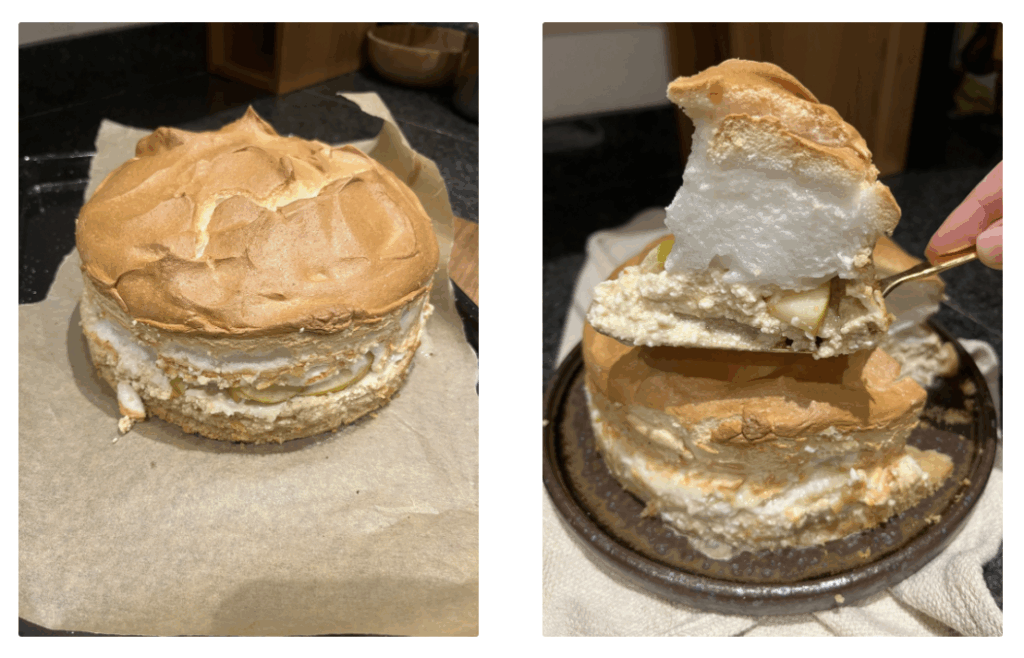
2. Stevia
Stevia is a more affordable alternative to monk fruit. I either buy pre-mixed stevia–erythritol blends or make my own. Right now, I’ve got a big jar of 1:8 stevia that I mix with erythritol when needed.
3. Chicory Root Syrup
I use this anywhere I want the stickiness of honey, but don’t want to use honey — in salad dressings, lemonades, or porridges.
4. Allulose
I use it for making caramel and condensed milk. The main downside is the price: it can be quite expensive. But it’s absolutely perfect when you want the real texture of sugar without using the actual sugar.
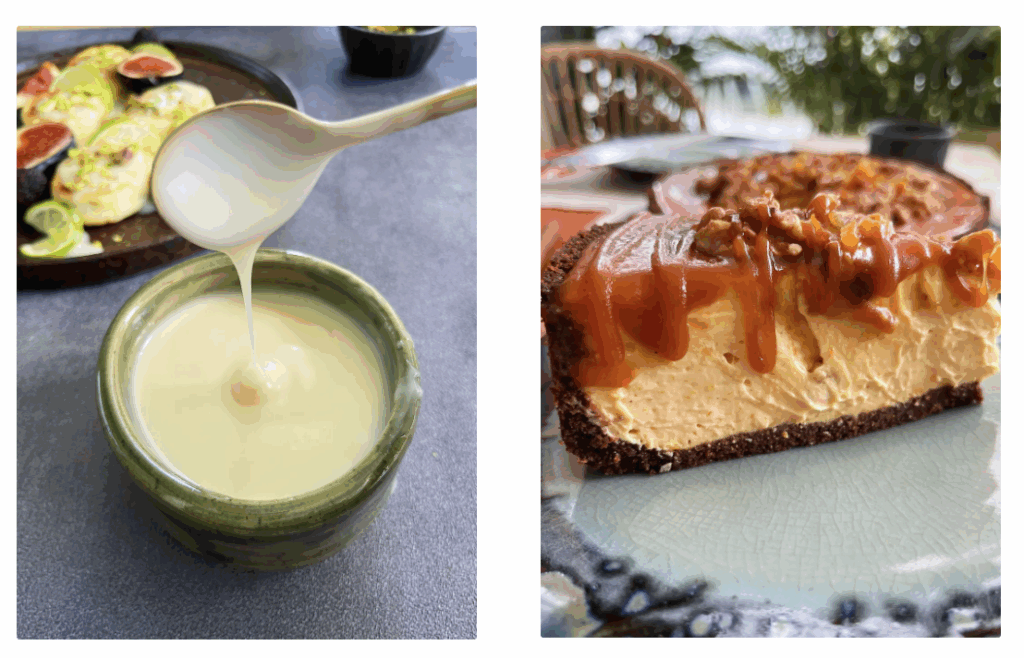
5. Isomalt
I use it for desserts with hard candy or caramel-style texture. It’s great for decoration or as a caramel “binder,” but you can’t make real caramel or condensed milk with it.
6. Monk Fruit Syrup
While I was living in Singapore, it was easier to find. In the UK, it’s not available. I used it the same way I’m using chicory root syrup.
Conclusion
- Sugar will always remain sugar, no matter where it is located. Choosing alternatives like honey or date syrup doesn’t make it inherently healthier when it comes to the amount of carbohydrates. The only real exception is chicory root syrup, as it works fundamentally differently.
- A sugar substitute is not sugar. Some are great for baking, others are better for sweetening ready food or drinks. It’s important to know what you’re using and why, to match it to your actual culinary needs.
- Not all sugar substitutes are equal. Some of them contain calories and carbs, which can matter if you have diabetes or are cutting back on sugar to manage your weight. And if you are using sweetener blends, you should always check their ingredients, so you don’t end up overpaying for cheaper fillers.
I’m not claiming that sugar substitutes are always a healthier alternative to sugar, and I’m not here to convince anyone to switch. There’s a lot of myth and marketing buzz around them, and much research is still in progress.
I’ve read many science papers and studies on the health impacts of sweeteners, and in the end, it really boils down to one thing: moderation. But honestly, that applies to everything about food: sugar, fat, even things like spinach and raspberries, which can harm your kidneys in excess.
As for me, sugar substitutes allowed me to live a full life and allowed me to continue to experiment with baking and dessert recipes, despite my T1D. I’m incredibly grateful for that.

